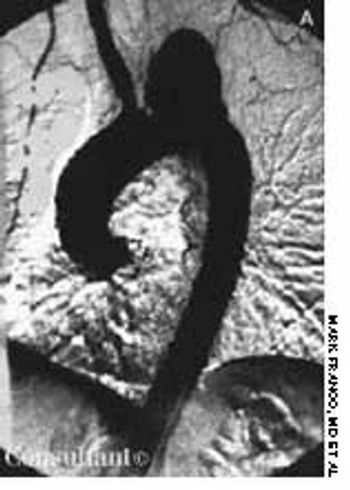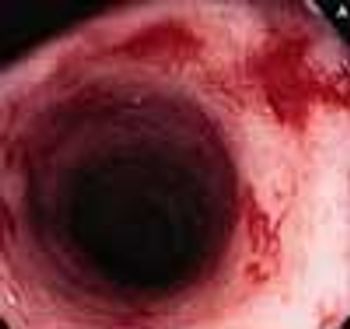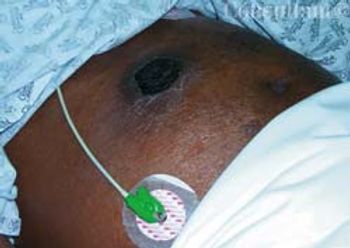
A 73-year-old man is admittedto the hospital with pulmonary tuberculosis.A 3-drug fixed combination-isoniazid, rifampicin, and pyrazinamide-and ethambutol are given.Within an hour, a global urticarialrash erupts (A and B).

A 73-year-old man is admittedto the hospital with pulmonary tuberculosis.A 3-drug fixed combination-isoniazid, rifampicin, and pyrazinamide-and ethambutol are given.Within an hour, a global urticarialrash erupts (A and B).

Highlights:➤What to tell your patients about thebenefits-and risks-of mammography.➤A realistic look at cancer screening: Arewe overstating the benefits?➤Which screening strategies you canrecommend with confidence.➤How best to bring the patient into thedecision-making process.

PSA velocity, not a man's absolute PSA level, is a better predictor of prostate cancer risk, according to a study from the Johns Hopkins School of Medicine. The findings suggest that screening should begin at age 40, not 50.

DALLAS -- As low-dose Propecia (finasteride) stimulates hair growth for male pattern baldness, it appears to suppress prostate specific antigen (PSA) levels, a researcher here reported.

During a routine checkup, a middle-aged woman asks you whether she should stop wearing moisturizers and makeup that contain sunscreen. She has read that increased sunlight exposure enhances vitamin D production, which may prevent certain types of cancer. What would you tell her?

ABSTRACT: Prostate-specific antigen (PSA) recurrence is the most common form of advanced prostate cancer. Salvage therapies may be effective even among some high-risk men, although long-term cancer control data are limited. The natural history of PSA recurrence is long but variable. The postrecurrence PSA doubling time can identify men at high risk for progression and death. Early hormonal therapy, possibly via combined androgen blockade, may reduce the risk of progression and improve cancer-specific survival among men with high-risk recurrence. Men with low-risk recurrences likely receive minimal benefit from aggressive early hormonal therapy and may actually be harmed.

SAN FRANCISCO -- Older men with limited life expectancies are getting screened much too often for prostate cancer, given the potential harm that may follow a positive test versus the likelihood of benefit, researchers here reported.

PHILADELPHIA -- External-beam radiation or brachytherapy for prostate cancer sometimes triggers a spike in prostate specific antigen levels, but researchers here said this "bounce" is not clinically significant.

BALTIMORE -- It's the rate of change of prostate specific antigen -- not the absolute PSA level -- that is the key to telling who has a life-threatening malignancy and who doesn't, according to researchers here.

NASHVILLE, Tenn. -- Weight, height, and race independently influence prostate-specific antigen (PSA) levels, and each may distort the risk of prostate cancer, researchers here reported.

An 82-year-old man presents with shoulder pain resulting from a fall the day before. He has had intermittent episodes of light-headedness, chest pain, and "flutterings in the chest" over the past week--including one this morning. Episodes last about 2 hours and resolve spontaneously. He denies any loss of consciousness, weakness, or worsening of symptoms with exertion. He also denies headache, abdominal pain, and other injuries. His medical history includes coronary artery disease (treated with bypass grafting 10 years earlier); prostate cancer; and chronic lymphocytic leukemia, for which he is receiving chemotherapy.

An 82-year-old man presents with shoulder pain resulting from a fall the day before. He has had intermittent episodes of light-headedness, chest pain, and "flutterings in the chest" over the past week--including one this morning.

SAN ANTONIO -- For men with newly diagnosed metastatic prostate cancer treated with androgen deprivation therapy, PSA levels at seven months seem to predict long-term survival or early failure.

SAN ANTONIO -- Proscar (finasteride) increased the sensitivity of prostate specific antigen (PSA) testing for both overall and high-grade prostate cancer, according to an analysis of a large trial, and did not perpetrate any extra aggressive malignancies.

LOS ANGELES - Men with rising PSA levels after definitive prostate cancer therapy had significant slowing of their PSA doubling time when they drank eight ounces of pomegranate juice daily, researchers here reported.

Two of my patients are older men (aged 62 years and 68years) who have benign prostatic hyperplasia; their prostatesare soft and nontender.

Here are two cases that demonstrate the discovery of aortic aneurysms through careful and complete physical examination and via radiographic studies obtained to evaluate other conditions.

A 48-year-old woman was hospitalized following 10 days of rectal bleeding. One year earlier, she had undergone combined external-beam radiation and brachytherapy for stage IIIA carcinoma of the cervix. The patient was orthostatic and pale on admission, and her hemoglobin level was 6 g/dL. After receiving a transfusion of packed red cells, she underwent colonoscopy. Several telangiectases were seen in the rectum, the mucosa was friable, and blood oozed from one of the lesions.

A 79-year-old man has an elevated prostate-specific antigen (PSA) level(11.3 ng/mL). About 1 month earlier, when he was hospitalized for a seriousurinary tract infection (UTI), his PSA level was 13.3 ng/mL. The more recentlevel was obtained after he received antibiotic therapy for the UTI.

ABSTRACT: Although the widespread use of prostate-specific antigen (PSA) testing has led to an increase in the number of cancers detected, controversies about the benefits of screening persist. No conclusive evidence has yet emerged that PSA screening reduces the mortality associated with prostate cancer. Thus, mass screening is not universally endorsed. The American Urologic Association and the American Cancer Society recommend that digital rectal examination and PSA testing be offered annually to men 50 years and older with an estimated life expec- tancy of 10 years or more. High-risk patients (those with a positive family history or those of African American descent) are advised to begin screening at age 45. The decision to screen is based on the patient's preference following a thorough discussion of the benefits and limitations of PSA testing. Refer to a urologist any patient with a PSA greater than 4.0 ng/mL. Also, be alert for high PSA velocity changes in patients undergoing annual screening, and refer those with a PSA velocity of more than 0.75 ng/mL/y.

A 78-year-old man with a history of asthma, coronary artery disease, chronic obstructive pulmonary disease (COPD), and recently diagnosed prostate cancer was admitted to the medical ICU with exacerbation of COPD. The obtunded patient was unable to provide a history. A 4 × 6-cm firm nodule of unknown duration was noted over the right upper quadrant of the patient’s abdomen. There were no other cutaneous lesions.

For 1 week, a 2-year-old boy has hadasymmetric erythematous patcheson the anterior trunk. There is nofamily or personal history of eczema.His mother has not used new soapsor detergents recently; there are nopets in the household.